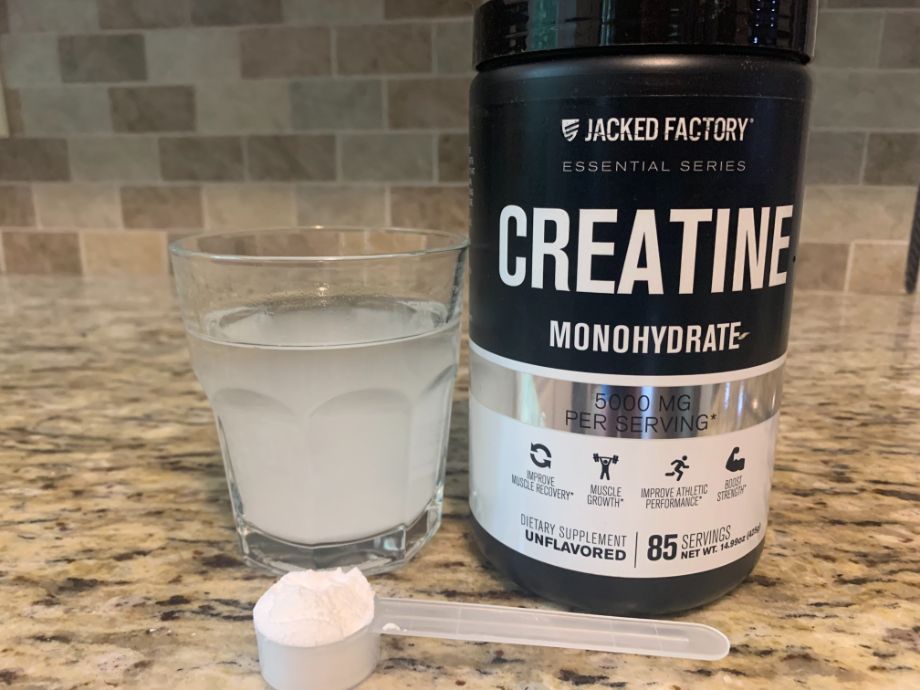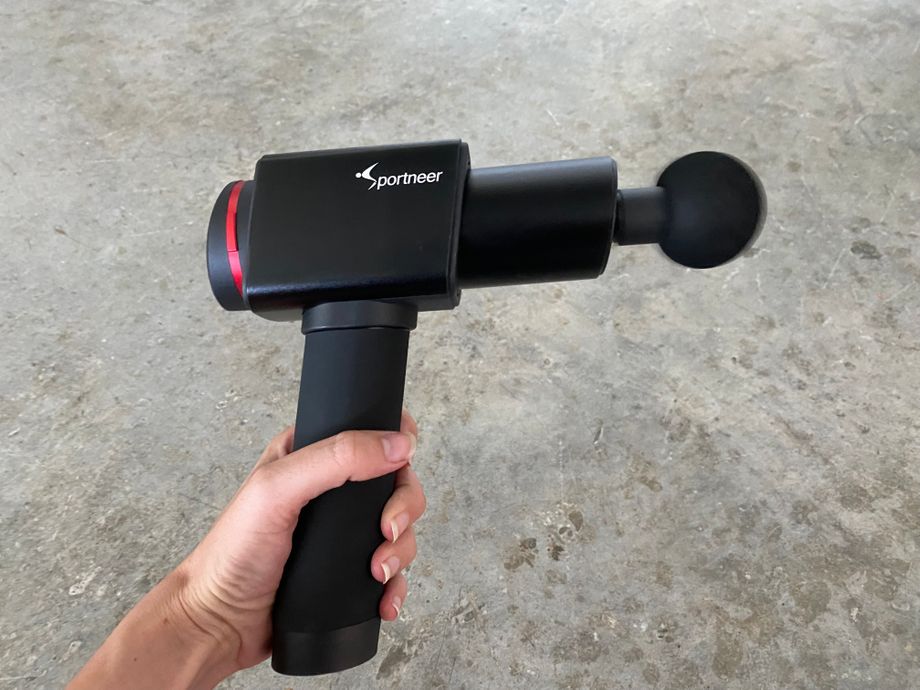Creatine and whey protein are the kings of the sports nutrition world among those who do resistance training. Creatine in particular has a more targeted function in muscle growth and helps with performance in high-intensity exercise.
RELATED: Creatine vs Whey
Creatine is a non-nutritive organic compound, meaning it does not contribute nutrition or calories, but is derived from three amino acids: arginine, glycine, and methionine. Since amino acids are natural compounds, this makes creatine very safe to take. However, with most supplements, the risk of side effects is always there if dosed improperly and the same goes with creatine use.
So, let’s talk about creatine monohydrate dosage. The short answer is that a proper dose is 3 to 5 grams, but read on to learn what the minimum amount you should take to optimize creatine stores is, the optimal dose to take for efficacy, and if creatine loading is a necessary practice.
RELATED: Best Creatine
Medical disclaimer: This article is intended for educational and informational purposes only. It is not intended as a substitute for medical advice. For health advice, contact a licensed healthcare provider.
What Creatine Monohydrate Dosage Should I Take?
Studies show that the optimal amount of creatine to maintain your creatine levels is a daily dose of 3-5 grams1 which is also the amount recommended by the International Society of Sports Nutrition. Most sports dietitians or nutritionists will tell you 5 grams, just because being on the high end will likely give your muscles the best creatine saturation without overdoing it.
It does not appear to matter when you take creatine2 as long as you take it as close to weightlifting or other exercise as possible, such as pre-workout or post-workout. It also appears that creatine works best when taken with a good source of carbohydrates, as the rise in insulin you get from carbohydrates helps with the uptake of creatine in the muscle, according to an article published in the Journal of the International Society of Sports Nutrition1.
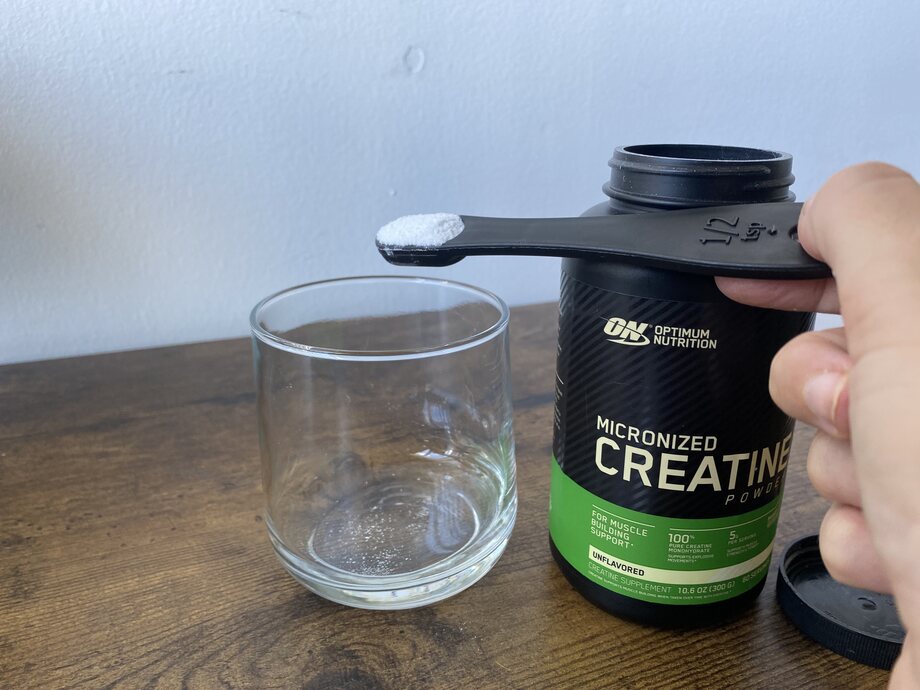
RELATED: Do You Take Creatine Before or After Workouts?
Creatine Loading Phase
As mentioned, the optimal, clinically effective dose is 5 grams of creatine (which is why this is the typical amount you’ll see in one serving of most creatine powders). However, there are some instances where people will take amounts higher than the recommended doses, such as during a creatine loading phase.
The typical loading protocol requires you to supplement with large amounts of creatine, about 20 to 25 grams for five to seven days. So, what happens to your body during this mission to stock up on those sweet creatine stores?
In a number of studies, it has been demonstrated that this method of supplementing with creatine is indeed effective in the short-term, especially when it comes to athletes who need to see the benefits of creatine in a very short time3 (30 days or less).
An athlete can also benefit from a loading phase if, for example, they need to gain a significant amount of weight within a short period of time by taking advantage of the water retention effect that creatine has. This may be the case for those who participate in weight-class sports or other competitions that require a specific weight to qualify for competing at a certain level.
In this case, the method of loading creatine is legit. As levels of creatine rise from the high doses, water is pulled into the muscle cells and this bloating can inflate body weight numbers. This loading protocol is an actual strategy that nutritionists use with their athletes to make weight.
Now, there are some warnings to be given here with a loading phase. If you want to avoid side effects from the high doses, you do not want to consume more than 10 grams of creatine all at once. If you don’t stagger your intake during the loading phase, you may experience unpleasant gastrointestinal distress such as stomach cramps, nausea, and diarrhea.
The biggest takeaway from the loading phase conversation—and I want you to circle and underline this—is that studies have shown that, outside of quick weight gain from bloating and some athletic performance benefits in the short-term, this loading protocol isn’t necessary4. It has been shown that there isn’t a big difference to be had in the gain of muscle mass in the long term whether you go through a loading phase or just take the lower dose.
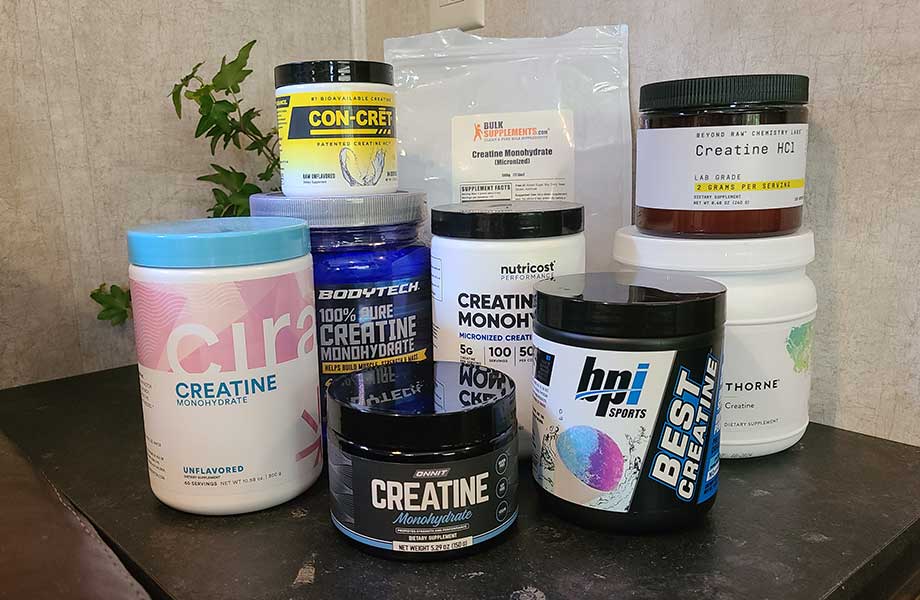
Types of Creatine
Due to the popularity of the dietary supplement, there are several types of creatine available for supplementation. The question is, how do they compare to creatine monohydrate, the most commonly consumed form?
Creatine Nitrate
As many athletes are aware, nitrates, also known as nitric oxide, are known to have some benefits for performance and health benefits. It has been shown that nitrates are able to help dilate the arteries, which can open them up and allow for more optimal blood flow and better oxygenation5.
Increasing the efficiency of oxygen transport can improve performance by delaying fatigue from lack of oxygen to the skeletal muscle. This is why elite and endurance athletes take supplements like beet juice, which is rich in nitrates.
So it makes sense that taking nitrate and creatine together will give you crazy sports performance benefits, right? Well, not really. Exercise performance was similar between creatine nitrate and creatine monohydrate in studies that compared the two6.
Creatine HCl
Advocators of creatine HCl claim that it promotes better uptake of creatine into the muscles by bonding creatine to hydrochloric acid. The belief comes mainly from a recent study7 showing creatine to be more water-soluble, 38 times more soluble actually, than creatine monohydrate.
Due to this, some people claim that, when you take creatine HCl, you can take a lower dose of creatine than if you were taking creatine monohydrate. Sounds nice, but there are no human studies that have shown this to be true.
RELATED: Creatine HCl vs Monohydrate
Creatine Citrate and Creatine Malate
Both products are available commercially as alternatives to creatine. Studies have shown that they do not differ from creatine monohydrate in terms of effectiveness8, however.
Malic acid, the malate portion of creatine monohydrate, has been shown to independently help with athletic performance in mice9, but not necessarily in conjunction with creatine, and this has not been able to be replicated in humans.
Creatine Ethyl Ester
Research has shown that this type of creatine is more bioavailable than other types, but a placebo-controlled study found that it works about the same as the placebo10. In other words, it does basically nothing, making it one of the worst forms of creatine to use for creatine supplementation.
In simple terms, it does not have an effect because it rapidly turns into creatinine after consumption, and creatinine essentially has no performance or health benefits.
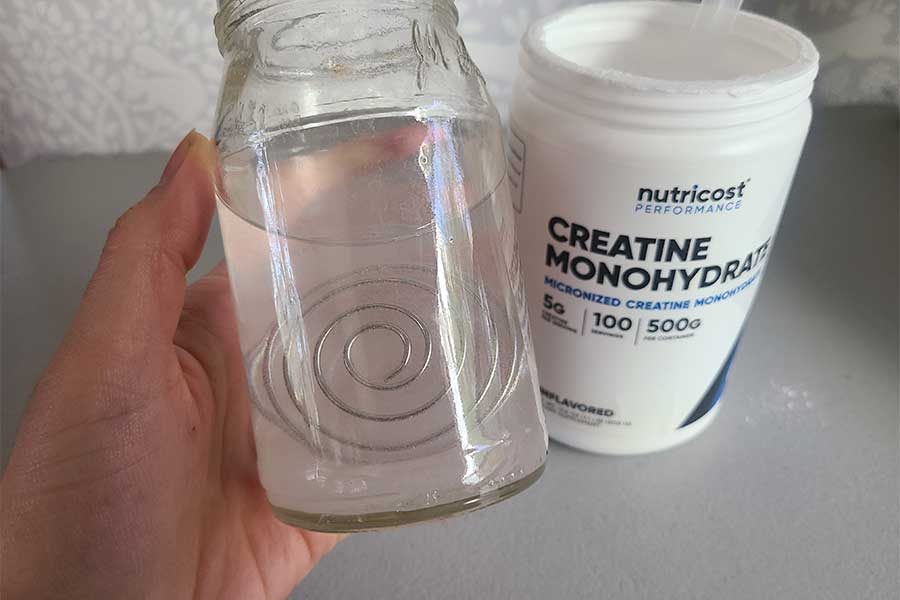
Creatine Monohydrate
Creatine monohydrate, the most commonly used and researched creatine supplement, appears to be just as effective, safe, and effective as every other form of creatine11. It’s just that simple.
In a recent review, creatine monohydrate was found to be by far the most affordable12 type of creatine available commercially. Creatine monohydrate, as you’ve probably gathered by now, is the most practical form of creatine you can take. No frills or fancy compounds needed.
Benefits of Creatine
So we talked about the recommended daily dose of creatine and the different forms available. Now, let’s talk about why you should consider even taking creatine to begin with and the creatine benefits you may encounter.
May Help Support Building Lean Body Mass
One of the most popular benefits of creatine supplementation is its well-established ability to change body composition13, particularly by increasing body mass in the form of muscle growth. Creatine has been shown to reliably help build muscle when combined with a resistance training program.
RELATED: Does Creatine Help Build Muscle?
May Help Improve Muscle Recovery
Creatine may also play a role in boosting muscle recovery and reducing soreness by generating more energy in muscle cells from ATP, or adenosine triphosphate. As a result, you can continue your high-intensity exercise even if your muscles are sore, keeping your muscle strength and helping you to perform at your best14.
May Help Prevent Muscle Mass Breakdown
In addition to fighting inflammation caused by exercise, creatine also helps prevent muscle loss, which negatively affects body composition and exercise performance. As a result, injured athletes will have much lower protein synthesis rates than they are used to due to a lack of resistance training.
One 2022 study13 found that creatine supplementation minimized muscle loss and enhanced strength among otherwise healthy individuals who were immobilized for an extended period of time.
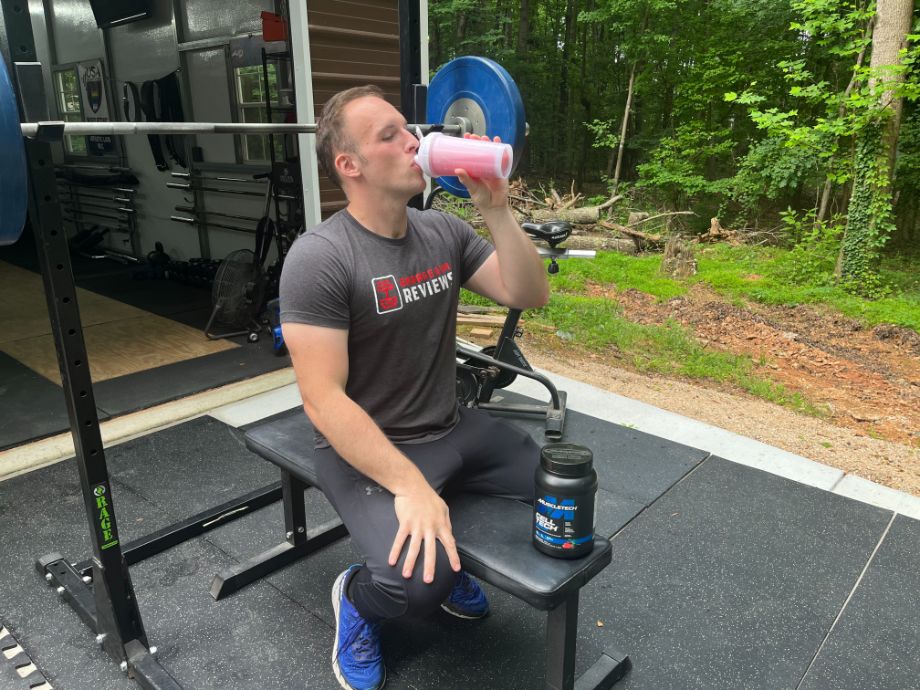
Assists in Increasing Muscle Strength
The most popular results showing the benefits of creatine on muscle strength were seen in a Penn State study15 that had healthy, adult men take 25 grams of creatine monohydrate daily. As a result, the men who took creatine were able to do 30% more reps than those who did not.
RELATED: Does Creatine Make You Stronger?
Beneficial for Older Adults
As a normal part of aging, our muscle mass and ability to build muscle begins to decline. Studies have shown that creatine supplementation in older adults can not only mitigate these effects and improve muscle mass, but can also improve quality of life. This is because lower levels of skeletal muscle are associated with higher fall risk, less independence, and overall less mobility in older adults16.
Finally, new research is beginning to lean toward creatine having benefits to cognitive function17, especially when supplemented in elderly adults.
Side Effects of Creatine
Plenty of research has established that creatine is safe when the recommended doses are taken. However, aside from wasting money, taking too much can have some unpleasant creatine side effects.
GI Distress
Many people make the mistake of not drinking enough water when they begin creatine supplementation. It can cause adverse effects on the gastrointestinal tract, such as diarrhea or stomach cramps.
RELATED: How Much Water Should You Drink with Creatine?
When you take the maintenance dose of 5 grams of creatine, as long as you stay hydrated, these effects are not as obvious as they are during the creatine loading phase, which requires you to take 20 grams of creatine.
Water Retention and Weight Gain
As creatine stores rise in the muscles, it also pulls water into muscle cells, which is just one of creatine’s muscle-building mechanisms. Despite concerns about this for those competing in weight-loss events or aesthetic competitions where body weight or puffy appearance is important, it is generally harmless and has no adverse effects in the short-term.
Who Should Not Take Creatine
If you have issues with liver disease, heart disease, or kidney function, you should not take creatine, as your body will not be able to safely metabolize it18. Furthermore, if you take any prescription medications or diuretics, you should consult with your doctor before starting any supplementation.
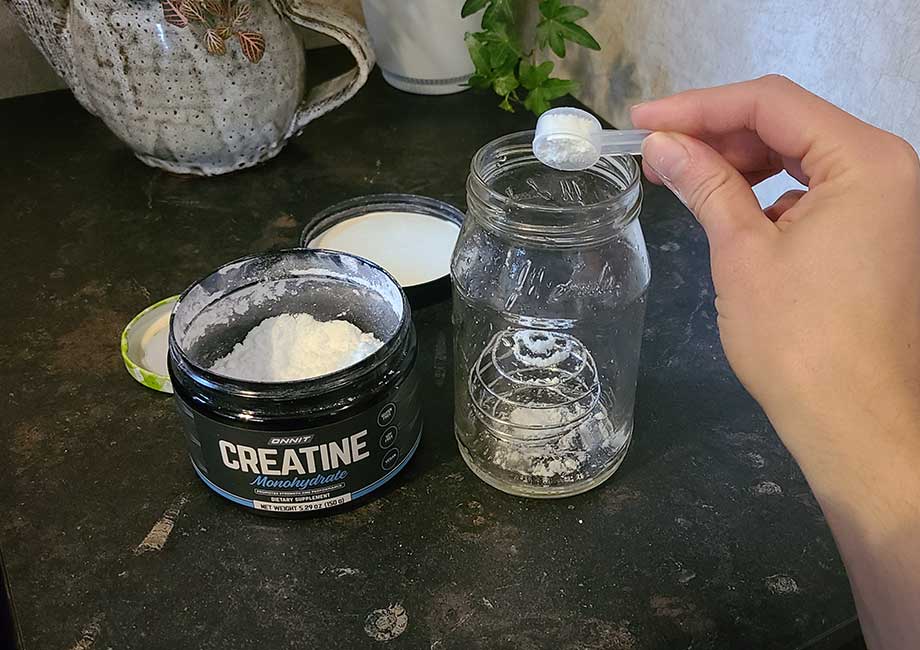
Creatine Monohydrate Dosage: Final Thoughts
The International Society of Sports Nutrition has established for quite some time that 5 grams of creatine monohydrate is the adequate creatine intake for optimal muscle creatine saturation. This is also called a “maintenance dose.”
If you choose to do a loading phase, the dosage shoots up to about 20 grams per loading protocol, but this is not necessary. Women, older adults, and vegetarians may have lower levels of muscle creatine and can greatly benefit from creatine supplementation. As far as types of creatine, creatine monohydrate appears to be the best choice all around.
All in all, creatine use, when dosed correctly, is a safe, effective, and practical addition to any bodybuilding or weightlifting regimen.
Creatine Monohydrate Dosage: FAQs
What is the typical dosage for creatine monohydrate?
The maintenance dose recommended to maintain adequate levels of creatine is 3 to 5 grams.
What does creatine monohydrate do?
Creatine helps the body produce more ATP, or adenosine triphosphate. Creatine also supports bodybuilding efforts through muscle growth and improves sports performance.
What are the short-term side effects of creatine monohydrate?
The most common side effects of creatine intake are bloating and slight gastrointestinal discomfort.
These statements have not been evaluated by the Food and Drug Administration. This product is not intended to diagnose, treat, cure, or prevent any diseases.
References
- Kreider RB, Kalman DS, Antonio J, et al. International Society of Sports Nutrition position stand: safety and efficacy of creatine supplementation in exercise, sport, and medicine. J Int Soc Sports Nutr. 2017;14:18. Published 2017 Jun 13. doi:10.1186/s12970-017-0173-z
- Naderi A, de Oliveira EP, Ziegenfuss TN, Willems MT. Timing, Optimal Dose and Intake Duration of Dietary Supplements with Evidence-Based Use in Sports Nutrition. J Exerc Nutrition Biochem. 2016;20(4):1-12. doi:10.20463/jenb.2016.0031
- Antonio J, Candow DG, Forbes SC, et al. Common questions and misconceptions about creatine supplementation: what does the scientific evidence really show?. J Int Soc Sports Nutr. 2021;18(1):13. Published 2021 Feb 8. doi:10.1186/s12970-021-00412-w
- Hultman E, Söderlund K, Timmons JA, Cederblad G, Greenhaff PL. Muscle creatine loading in men. J Appl Physiol (1985). 1996;81(1):232-237. doi:10.1152/jappl.1996.81.1.232
- Macuh M, Knap B. Effects of Nitrate Supplementation on Exercise Performance in Humans: A Narrative Review. Nutrients. 2021;13(9):3183. Published 2021 Sep 13. doi:10.3390/nu13093183
- Galvan E, Walker DK, Simbo SY, et al. Acute and chronic safety and efficacy of dose dependent creatine nitrate supplementation and exercise performance. J Int Soc Sports Nutr. 2016;13:12. Published 2016 Mar 31. doi:10.1186/s12970-016-0124-0
- Gufford BT, Sriraghavan K, Miller NJ, et al. Physicochemical characterization of creatine N-methylguanidinium salts. J Diet Suppl. 2010;7(3):240-252. doi:10.3109/19390211.2010.491507
- Jäger R, Harris RC, Purpura M, Francaux M. Comparison of new forms of creatine in raising plasma creatine levels. J Int Soc Sports Nutr. 2007;4:17. Published 2007 Nov 12. doi:10.1186/1550-2783-4-17
- Wu JL, Wu QP, Huang JM, Chen R, Cai M, Tan JB. Effects of L-malate on physical stamina and activities of enzymes related to the malate-aspartate shuttle in liver of mice. Physiol Res. 2007;56(2):213-220. doi:10.33549/physiolres.930937
- Spillane M, Schoch R, Cooke M, et al. The effects of creatine ethyl ester supplementation combined with heavy resistance training on body composition, muscle performance, and serum and muscle creatine levels. J Int Soc Sports Nutr. 2009;6:6. Published 2009 Feb 19. doi:10.1186/1550-2783-6-6
- Wax B, Kerksick CM, Jagim AR, Mayo JJ, Lyons BC, Kreider RB. Creatine for Exercise and Sports Performance, with Recovery Considerations for Healthy Populations. Nutrients. 2021;13(6):1915. Published 2021 Jun 2. doi:10.3390/nu13061915
- Fazio, C; Elder, C; Harris, M. Efficacy of Alternative Forms of Creatine Supplementation on Improving Performance and Body Composition in Healthy Subjects: A Systematic Review. Journal of Strength and Conditioning Research, February 11, 2021. | DOI: 10.1519/JSC.0000000000003873
- Wu SH, Chen KL, Hsu C, et al. Creatine Supplementation for Muscle Growth: A Scoping Review of Randomized Clinical Trials from 2012 to 2021. Nutrients. 2022;14(6):1255. Published 2022 Mar 16. doi:10.3390/nu14061255
- Volek JS, Ratamess NA, Rubin MR, et al. The effects of creatine supplementation on muscular performance and body composition responses to short-term resistance training overreaching. Eur J Appl Physiol. 2004;91(5-6):628-637. doi:10.1007/s00421-003-1031-z
- Kreider RB. Effects of creatine supplementation on performance and training adaptations. Mol Cell Biochem. 2003;244(1-2):89-94.
- Candow DG, Forbes SC, Chilibeck PD, Cornish SM, Antonio J, Kreider RB. Effectiveness of Creatine Supplementation on Aging Muscle and Bone: Focus on Falls Prevention and Inflammation. J Clin Med. 2019;8(4):488. Published 2019 Apr 11. doi:10.3390/jcm8040488
- Rawson ES, Venezia AC. Use of creatine in the elderly and evidence for effects on cognitive function in young and old. Amino Acids. 2011;40(5):1349-1362. doi:10.1007/s00726-011-0855-9
- Vega J, Huidobro E JP. Efectos en la función renal de la suplementación de creatina con fines deportivos [Effects of creatine supplementation on renal function]. Rev Med Chil. 2019;147(5):628-633. doi:10.4067/S0034-98872019000500628


